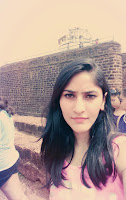SA Travel Diaries: A Memoir of My Visit to the Aguada Fort Goa— Snippets straight out of the journal of Rakshanda Thakur, SA Volunteer
Tuesday, 27 October, 2015
Dear Diary,
I am in Goa, at last (which explains the absence on the writing front!)
 |
| At Aguada Fort |
Today, though, Aguada Fort was on the itinerary and I was all excited and thrilled about it, of course, because of my unending love for historic places. The ulterior motive though, is because it is my first week volunteering for Speaking Archaeologically and I am the only one, to have taken an exemption from the very first task because of the trip. I felt awful, but then my task in charge, Shriya Gautam, gave me a list of places I could gather information about, for SA and make up for the exemption. Aguada Fort happened to be on the list and turns out, it will be the only one I shall cover and I can hardly wait to do it right!
The Visit
The impression I had of the place, on first hearing that it was a Lighthouse Fort, was rather typical — I imagined it as a light brown, bricked, huge circular structure, with a few cannons on the outside and a that typical European interior with paintings and antiques.
What I didn't know was that I was in for a surprise!
We reached the Aguada around 12:00 in the afternoon and it wasn't the best time to visit it! The sun was right above the head and the day was sweltering hot!
 We were given half an hour to explore the place. I was all ready, with my camera and eyes open, to take in as much information as I could. As I walked towards the fort, the first thing I noticed about it, was the expanse of red soil, then the corresponding red walls of the Fort. There was a passage, at the entrance that led to the lighthouse, which was a majestic structure with white circular walls. The ravishes of time were visible, the paint had worn out and was chipped in places. The view from the hill top was, however, breathtaking!
We were given half an hour to explore the place. I was all ready, with my camera and eyes open, to take in as much information as I could. As I walked towards the fort, the first thing I noticed about it, was the expanse of red soil, then the corresponding red walls of the Fort. There was a passage, at the entrance that led to the lighthouse, which was a majestic structure with white circular walls. The ravishes of time were visible, the paint had worn out and was chipped in places. The view from the hill top was, however, breathtaking!The temperature forced my friends to retire to the bus and I was left all by myself to do the sight seeing. I looked around the Upper Fort and Information Boards(courtesy the Archaeological Society of India) lay scattered about the place.
I was glad to see them as half my work was served in a platter and I was only left with taking pictures of the fort. There was also a model of the Fort, which showed it in its entirety and also, perhaps, how it would have been during its prime.
Unfortunately, some areas of the were restricted to the public. All that the public can see of the prison is a ventilation shaft. It was a magnificent structure and as I stood and looked out to the sea I could almost imagine the Portuguese ships being guided by the Lighthouse.
What Happened eventually?
The main twist to my romance with Aguada Fort for Speaking Archaeologically, came in much later, in January 2016, when I was paired with fellow volunteer Anmol Chacko for a task on this fort.
The fact that I had visited the place helped us in writing the article with a personal understanding and some sort of connection. Back when I was covering the Aguada Fort and noting things down in my journal, I had no idea that my experiences would serve as a memoir— or what Shriya calls the primary information report.
Yes, we do write research papers, as many as a tiring 5 original papers a month and submit it before the unrelenting, unforgiving eyes of the Panelists. What I did not know, back in Week 1 of Volunteering that every task, every site visit and every object thrust into our hands always evolves into a task, sometimes, in an almost serendipitous manner.
Aguada was both my SA Site Cover and my task, and my work on it made me realise that archaeology isn't always about the history of the site — it is also about your history with the site!
The fact that I had visited the place helped us in writing the article with a personal understanding and some sort of connection. Back when I was covering the Aguada Fort and noting things down in my journal, I had no idea that my experiences would serve as a memoir— or what Shriya calls the primary information report.
Yes, we do write research papers, as many as a tiring 5 original papers a month and submit it before the unrelenting, unforgiving eyes of the Panelists. What I did not know, back in Week 1 of Volunteering that every task, every site visit and every object thrust into our hands always evolves into a task, sometimes, in an almost serendipitous manner.
Aguada was both my SA Site Cover and my task, and my work on it made me realise that archaeology isn't always about the history of the site — it is also about your history with the site!



Comments
Post a Comment